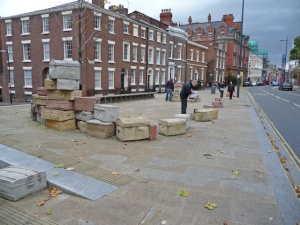I have done my first walking meeting!
What is a walking meeting? I first came across this via my colleague who ran a postgraduate workshop. The idea is that rather than being stuck in an office, you take a walk with your meeting partner. And this walk will be creative, open – with unexpected outcomes as well as being a healthy way of spending your work time. See more by Nilofer Merchant’s TED talk:
And of course, everything started with the classics: see Aristotle’s Peripatetic school.
So it happened. I met up with Gwenda Mynott, LJMU, at a research conference. We shared the same interests, by accident turned out to be neighbours at a different institution. We didn’t need any papers to talk over and the weather was nice and Gwenda was open to try it, so here is what happened:
We met outside, and took a walk – mostly in a nearest point of tourist interest. But the first corner was actually my old masters institution, so inevitably started talking about my masters. Turns out Gwenda used to teach on this programme a few years after, something we may not have discovered otherwise!
But without the details of our walk & talk, what I observed is that walking through the city and the buildings gave us points to talk about, sometimes work-related, sometimes personal. We kept on talking and sharing our research interests. Since then I talked to others, and we agreed that you ‘think’ differently when walking. You usually have a starting point and end end point of your journey, and perhaps this gives an unconscious frame to your talk. A bit like the thinking space of a train journey. I usually do my long term planning on a train – a train journey and that tiny little desk in front of me with papers somehow gives me space to think about without being bogged down in the detail.
My reflections:
- The walking meeting works! (If you haven’t got many people and you don’t have to talk over reports or papers.)
- Ideal for a first, exploratory meeting.
- Where you walk can guide the conversation.
My next steps:
I am meeting up someone who is thinking about curriculum change. I am thinking that rather than meeting in an office, we could do a campus walk at places or buildings, rooms where his students are taught – to give us sparks, new insights and ideas about different teaching approaches.
Further reading:
Since I discussed this idea with colleagues, I got the following recommendations to explore:
http://www.theschooloflife.com
http://www.theschooloflife.com/shop/connecting-with-the-city/




